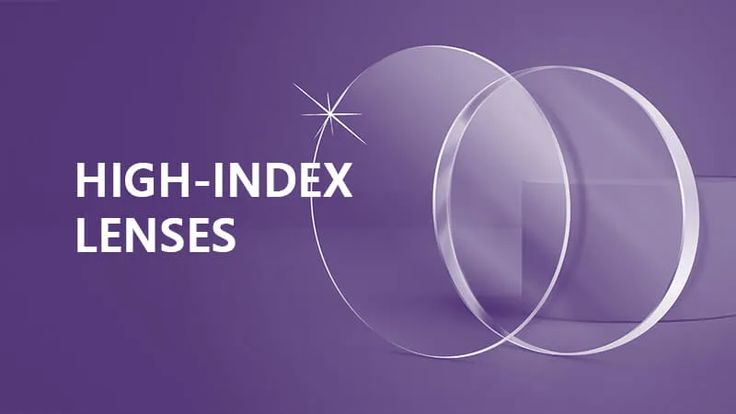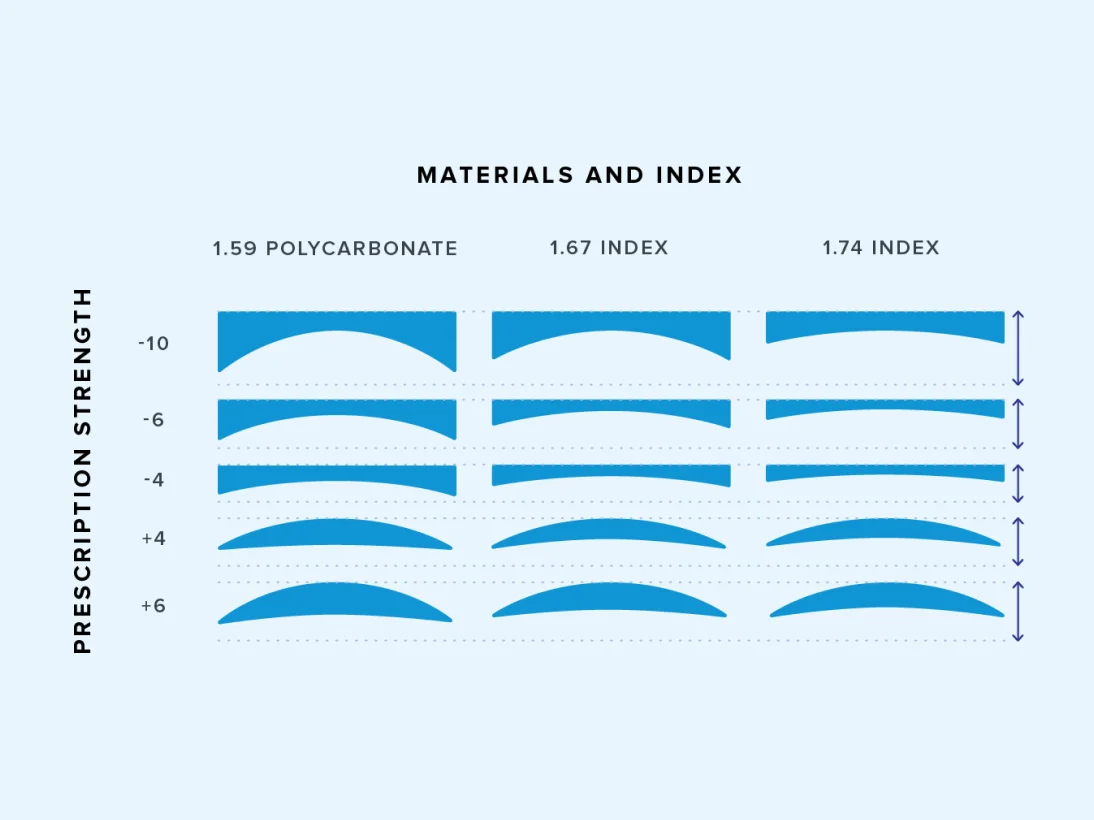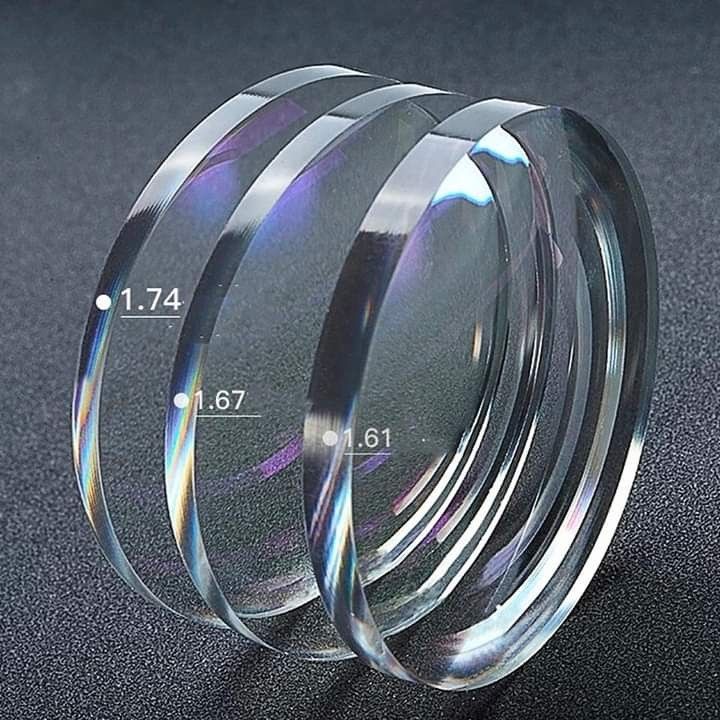Overview

High-index lenses with ultra-thin design
In today’s modern world, not only technology but also the field of optics has made remarkable progress. One of the most significant advancements for people with severe refractive errors is the development of high-index lenses—a solution that delivers clearer vision while maintaining both comfort and aesthetics.
What Are High-Index Lenses?
“High-index lenses” (also known as ultra-thin lenses) are made from materials that bend light more efficiently than standard lenses. As a result, for the same prescription strength, high-index lenses can be significantly thinner and lighter.
For example, someone with -6.00D myopia wearing standard lenses would need thick, heavy glasses that may affect appearance. By switching to lenses with a higher refractive index (such as 1.67 or 1.74), the lens thickness can be reduced by up to half, making the glasses slimmer and more elegant.
How Do High-Index Lenses Work?
Each lens material has a “refractive index” that determines how efficiently it bends light. The higher the refractive index, the more the light bends—meaning the lens requires less curvature to correct vision effectively.
This allows the lenses to be cut thinner and lighter while maintaining the same optical correction. Common refractive indices include:
- 1.50 (CR-39 plastic – standard)
- 1.59 (Polycarbonate – thin, lightweight, impact-resistant)
- 1.67 – 1.74 (High-index plastic – ultra-thin and premium)
Typically, a lens is considered “high-index” when its refractive index is 1.60 or higher.
Advantages of High-Index Lenses

Comparison of lens thickness across 1.59, 1.67, and 1.74 refractive indices
Compared to conventional lenses, high-index lenses offer several outstanding benefits:
- Enhanced aesthetics – thinner and sleeker lenses
High-index lenses reduce the edge thickness (for myopia) or center thickness (for hyperopia), making the wearer’s face appear more balanced. This helps minimize the “bulging eye” effect that thick lenses often create, giving the wearer a more natural and proportional look.
- Lighter and more comfortable for long wear
Thanks to their compact design, these lenses weigh up to 30% less than standard ones, reducing pressure on the nose bridge and ears. The result is less slippage, no indentations, and an overall better wearing experience — especially for those who wear glasses full-time.
- Superior optical clarity
Manufactured from advanced optical-grade plastics, high-index lenses reduce peripheral distortion and enhance clarity across the entire surface. The difference is particularly noticeable when driving, reading, or working at a computer for long hours.
- Flexible customization options
They can be combined with a variety of coatings and treatments such as anti-reflective (AR) coating, UV protection, blue light filtering, or photochromic layers that darken in sunlight. This versatility allows users to personalize their lenses according to their habits and environment.
Considerations Before Choosing High-Index Lenses

High-index lenses 1.61, 1.67, and 1.74 with different thickness levels
Despite their benefits, there are some factors to keep in mind when choosing high-index lenses:
- The complex manufacturing process and premium materials make high-index lenses two to four times more expensive than standard lenses.
- Because they bend light more strongly, they also reflect more light, which can cause glare, especially at night. Adding an anti-reflective coating (AR coating) helps reduce reflections and improves visual clarity.
- Ultra-thin materials tend to be more brittle and less impact-resistant, so they are not ideal for children or contact sports.
Difference Between 1.67 and 1.74 High-Index Lenses
The two most common high-index lenses today are 1.67 and 1.74, both suitable for strong prescriptions. However, they differ in several aspects:
| Criteria | 1.67 Index Lenses | 1.74 Index Lenses |
|---|---|---|
| Thickness | Thin, lightweight, balanced between aesthetics and durability | Ultra-thin – about 10% thinner than 1.67 lenses |
| Ideal Prescription Range | -3.00D to -8.00D | Above -8.00D or very high prescriptions |
| Price | Affordable and popular | More expensive and premium |
| Aesthetic Appearance | Significantly thinner edges | Nearly flat and extremely sleek |
Those with very high prescriptions or a strong focus on aesthetics will find the 1.74 option unmatched in thinness and elegance. For most others, the 1.67 remains the most practical balance of cost, durability, and beauty.
Who Should Wear High-Index Lenses?
You may want to consider high-index lenses if you:
- Have strong myopia, hyperopia, or astigmatism (typically ±4.00D or higher)
- Prefer a thinner, more aesthetic look, especially with rimless or semi-rimless frames
- Need lightweight lenses for all-day comfort
- Have a smaller face or low nose bridge, and want glasses that fit well without slipping
Is It Worth Investing in High-Index Lenses?
If you see your glasses as an everyday essential, investing in high-index lenses is absolutely worthwhile. The initial cost difference is justified by their long-term benefits—sleeker appearance, lighter weight, and lasting comfort. In addition, premium lenses help protect your eyes, reduce eye strain, and maintain visual stability over time.
To achieve the best results, you should:
- Have regular eye exams at reputable eye clinics.
- Consult with specialists to choose the right refractive index based on your prescription and frame style.
- Opt for certified optical lenses from trusted manufacturers to ensure safety and quality.
High-index lenses are more than just thinner lenses—they are a modern solution for people with high refractive errors, offering both visual clarity and confidence. Whether you need sharp vision for work or prefer a refined look, high-index lenses are a worthy investment for enhancing your daily visual experience.

 vi
vi 30-Oct-2025
30-Oct-2025











 0916.741.763
0916.741.763 Appointment
Appointment